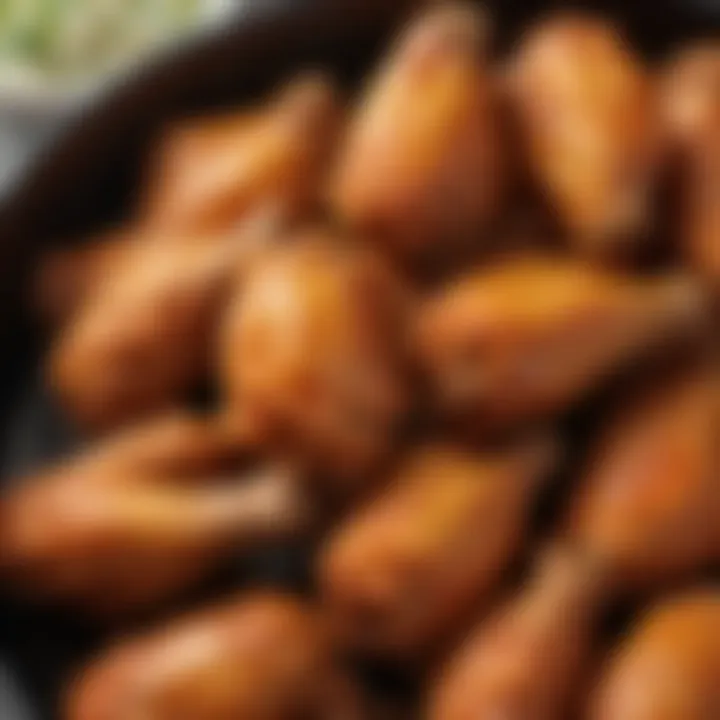Mastering Buffalo Wings in the Air Fryer: A Complete Guide


Intro
In recent years, air fryers have grown in popularity due to their ability to produce crispy, delicious food with less oil. One such dish that has caught the attention of many is buffalo wings. These flavorful, spicy chicken wings are iconic among snack lovers and casual diners. Cooking buffalo wings in an air fryer provides affordability, ease, and a healthier preparation method compared to traditional frying.
This comprehensive guide provides a deep dive into the benefits of using an air fryer for making buffalo wings. By the end of this article, you will have all the necessary information to create a perfect batch of wings that blend flavor with practical cooking methods.
Recipe Highlight
- Enticing Name: Crispy Air Fryer Buffalo Wings
- Essential Ingredients:
- Estimated Preparation Time: 10 minutes prep and about 25 to 30 minutes cooking time
- Servings: Perfect for 4 people
- Chicken wings (about 2 pounds)
- Baking powder
- Salt
- Black pepper
- Garlic powder
- Buffalo sauce
- Optional: butter for rolling wings in sauce
Step-by-Step Instructions
- Preparation: Start by rinsing the chicken wings under cold water and patting them dry with paper towels.
- Season: In a bowl, mix the baking powder, salt, black pepper, and garlic powder.
- Coat: Sprinkle the spice mixture over the wings, making sure to coat them evenly.
- Preheat: Set your air fryer to preheat at 375°F (190°C) for about 5 minutes.
- Arrange Wings: Place the wings in a single layer within the air fryer basket. Don't overcrowd.
- Cook: Air fry for 25 to 30 minutes, shaking the basket occasionally for even cooking. Wings should be crispy and golden brown when done.
- Sauce: Dip the wings in the buffalo sauce, or mix melted butter with the sauce for a richer flavor.
- Cooking Techniques: Using baking powder crisps up the skin. Being sure not to overcrowd the fryer can prevent uneven crispiness.
- Common Mistakes: Not drying the wings well; it's essential for crispy skin. Overcrowding the basket during cooking can result in less-than-ideal texture.
Variations and Substitutions
- Consider using cauliflower wings as a low-carb substitute.
- For a different flavor profile, try Asian-based sauces like teriyaki or chili garlic, instead of buffalo sauce.
- Add spices like cayenne pepper or smoked paprika for extra kick if desired.
Time-Saving Cooking Tips
- Prep ahead: You can wash and dry the wings the night before; marinating them can help blend flavors.
- Tools: An Instant Read thermometer can help ensure perfect cooking. Aluminum foil trays or pre-made spice mixes can cut cooking time.
- Batch cooking: Make a larger batch and store leftovers. Keep them in an airtight container for reheating later in the week.
Nutritional Information
- Calories per Serving: Approximately 400 calories per serving, excluding added sauces.
- Key Nutrients: Rich in protein, with usually lower levels of carbohydrates and fats. They are also an excellent source of selenium and Vitamine B6.
- Diet Plan Suitability: Can be suitable for keto with specific sauces, while others can adapt based on dietary needs.
Prolusion to Air Frying
Air frying has gain significant popularity among home cooks seeking convenient and healthier cooking methods. Its rise in fame stems from the ability to create crispy and delicious food, often mimicking deep-frying results, but with considerably less oil. This process has transformative potential, especially when preparing dishes that were once predominately reliant on frying techniques.
What is an Air Fryer?
An air fryer is a compact appliance that cooks food by circulating hot air around it, a concept known as convection cooking. Through this mechanism, it forms a crisp outer layer much like frying, without the need for excessive oil. The appliance usually contains a heating element and a fan to initiate this airflow, enabling even and efficient cooking. As the hot air envelops the food, it activates the Maillard reaction—culminating in golden-brown, crunch surfaces.
The air fryer caters to various recipes, making it versatile for cooking favorites such as fried chicken, French fries, and, notably, buffalo wings. It serves both as an efficient vitality booster for casual cooking and a serious upgrade for more experimental meal preparation.
Benefits of Using an Air Fryer?
Air fryers offer several benefits that cater well to contemporary lifestyles. Below are a few noteworthy advantages:
- Healthier Cooking: One of the main draws of air frying is the reduced consumption of oil. Many traditional recipes demand higher oil content, adding unnecessary calories and fat. With an air fryer, individuals can drastically lower fat intake.
- Speed and Efficiency: These appliances typically cook food faster than conventional ovens. The quick preheating times and enhanced heat circulation allow users to prepare meals in less time, which is vital for busy lifestyles.
- Ease of Use: Simplistic controls and cleaning features enhance the practicality of an air fryer. Most retain easy-to-operate settings allowing for intuitive adjustments without advanced culinary skills.
- Versatility: Beyond frying, experimenting with baking, grilling, and roasting expands the scope of the air fryer's functionality, making it a worthy addition to any kitchen.
The integration of air frying technology brings not just health advantages, but significantly eases the meal-prepping process in diverse culinary tasks.
These benefits underline the growing interest in air fryers and their application in preparing beloved dishes, such as buffalo wings.
Understanding Buffalo Wings
Buffalo wings are more than just a dish; they are a cultural phenomenon. Their significance lies not only in their flavor but also in their history and the way they have shaped culinary traditions in America. The journey from modest chicken wing to celebrated appetizer demonstrates how a simple food can become a favorite in bars, homes, and restaurants alike.
Understanding buffalo wings prepares the culinary enthusiast to appreciate this dish at a deeper level. It aids in grasping what makes the wings so appealing, including specific elements such as their preparation, flavor profiles, and the social context in which they are enjoyed.
History of Buffalo Wings
The history of buffalo wings dates back to 1964 in Buffalo, New York. Teressa Bellissimo invented the dish as a late-night snack for her son and his friends. Combining deep-fried wings with a cayenne pepper hot sauce and serving them with blue cheese dressing quickly became popular. Over the years, the dish transitioned from local delicacy to nationwide staple. It was officially recognized with the introduction of National Buffalo Wing Festival in 2002.
The history is essential to understanding the dish today. It connects people to shared experiences and local legacies. A discussion about buffalo wings must include this context to appreciate their evolution in American cities and cultures. Thus, knowing this backstory can enhance the cooking experience.
Classic Ingredients in Buffalo Wings


Buffalo wings are cherished for their bold flavors. To prepare them right, knowing classic ingredients is key. The core elements are as follows:
- Chicken Wings: Fresh, high-quality chicken wings serve as the foundation. The choice of wings significantly influences the end result.
- Cayenne Pepper Sauce: Typically, Frank’s RedHot Sauce reigns supreme. It adds the classic flavor that defines buffalo wings.
- Butter: Melting butter into the sauce softens the heat and adds richness.
- Celery Sticks & Carrot Sticks: Served alongside wings, they cut through the rich flavors.
- Blue Cheese Dressing or Ranch Dressing: Foundational in serving, these dressings offer cooling counterpoints.
These ingredients work in harmony to create the dish's characteristic flavor. Barbecue sauces and other variations include additional spices or unique ingredients providing variety. However, sticking to the basics is often recommended for authentic buffalo wings experience.
Preparing Buffalo Wings in an Air Fryer
Preparing Buffalo wings in an air fryer is a crucial step in this guide, as it blends culinary tradition with modern technology. The air fryer offers a healthier cooking method while replicating the crispy texture that is characteristic of classic buffalo wings. One of the primary benefits of using this appliance is that it significantly reduces the amount of oil needed, leading to wings that maintain high taste but have less fat. In addition, air frying allows for a quicker cooking time and more evenly cooked wings, which is especially important for family gatherings or game day parties.
When considering how to prepare Buffalo wings, understanding both the essential ingredients and the right tools is fundamental. This informs the cooking process, making it simple and stress-free. Below are the integral components we'll focus on:
Essential Ingredients
To create exceptional Buffalo wings, the quality of the ingredients plays a significant role. Here are key constituents for success:
- Chicken Wings: Fresh or frozen, quality chicken wings are essential for better flavor. Look for wings that are well-trimmed and plump.
- Buffalo Sauce: Frank's RedHot is a popular choice, known for its ability to meld flavors perfectly. However, feel free to explore homemade options if you prefer.
- Butter: This adds richness. Whether you use unsalted or salted, butter smoothens the spice of your sauce.
- Garlic Powder and Paprika: These seasonings enhance the taste of the wings and add depth without overshadowing the main flavors.
In addition to these, some cooks might choose to include a dry rub as a flavorful base before adding sauce, intertwining sweet and spicy notes for a balanced taste. Collectively, the right combination of ingredients elevates the wings from simple snacks to gourmet dishes.
Equipment Needed
While the ingredients are vital for flavor, having the right equipment is equally necessary. The following tools will improve the process:
- Air Fryer: Invest in one with adjustable temperature settings and sufficient capacity for your cooking needs.
- Mixing Bowls: A couple of mixing bowls are necessary for marinating the wings and mixing spices or sauces.
- Meat Thermometer: Ensuring the proper doneness is essential to food safety and quality.
- Tongs: To safely remove wings from the fryer and toss them in the sauce after cooking.
Using these tools correctly helps to produce wings that are not only tasty but also satisfying. The significance of preparation cannot be understated, as both ingredients and equipment paves the way for a successful cooking experience.
Cooking Techniques
Cooking techniques play a crucial role in preparing buffalo wings effectively in an air fryer. The differences in cooking methods not only affect the outcome of the wings in terms of flavor and texture but also impact the overall experience for the eater. Employing proper cooking techniques ensures that the wings are zesty, tender, and maintain a pleasant crispy outer texture while being succulent inside. This is where the knowledge of marinating and effectively setting up the air fryer becomes essential.
Marinating the Wings
Marinading is a key step when preparing buffalo wings. A good marinade enhances the flavor and ensures cohesion between the chicken and the undertaken flavors. Here are some vital points about marinating:
- Flavor Infusion: Marinating allows the chicken to absorb spices and sauces deeply. The result is wings that burst with flavor.
- Tenderizing: Many marinades include acidic components, like vinegar or citrus juice. They work to break down chicken's protein, resulting in more tender meat.
- Time Consideration: While some marinades require only a short time, it's ideal to let the wings sit in the marinade for at least one hour. Ideally, overnight in a refrigerator enhances flavor complexity.
Common Marinade Ingredients
- Hot sauce
- Garlic powder
- Onion powder
- Salt and pepper
- Butter or olive oil
A good marinade can uplift even basic ingredients into a flavorful feast.
To prepare the wings, blend these ingredients in a large bowl. Then, add the wings, ensuring they’re well coated. Store them covered in the refrigerator, allowing the acids and spices to do their magic.
Setting Up the Air Fryer
Getting your air fryer ready is a pivotal step in cooking buffalo wings. Optimization of your air fryer setup not only leads to even cooking but also some potential health benefits like less oil use.
- Preheat: Always preheat your air fryer before cooking. Most air fryers have this function to help achieve the optimal cooking temperature, creating a crispy outer layer.
- Temperature Settings: For buffalo wings, the ideal temperature is in the 370°F range. This level is generally perfect for crispiness without overcooking.
- Baskets and Trays: Make sure the basket is clean. Depending on the model, placing a parchment paper or copper tray at the bottom can prevent sticking, promoting an easier clean-up process afterwards.
Ensure even air circulation by avoid overcrowding the basket. Air fryers rely on hot air to cook food quickly and evenly, so the wings should be laid out in a single layer, leaving some space between each piece.
By ensuring your air fryer’s settings and preparedness are up to standard, the cooked wings can achieve the optimal taste and mouthfeel you expect in a buffalo wing.
Step-by-Step Cooking Instructions
Providing clear step-by-step cooking instructions is vital in this article about buffalo wings in an air fryer. These instructions guide readers through each phase of the cooking process, allowing them to prepare buffalo wings with confidence. Following a structured approach minimizes common cooking mistakes and unleashes the full flavor potential of the wings. Good instructions lead to consistency and make each cooking attempt more enjoyable.
Preparing the Wings
Preparing the wings is the first crucial step in this process. The choice of chicken wings is critical; it’s advisable to use fresh or properly thawed wings to ensure even cooking. Start by trimming excess fat and cleaning the wings thoroughly. This process helps in enhancing the overall texture and flavor. If desired, toss the wings in a mixture of salt, pepper, and your key spices before marinating. This early seasoning helps in ensuring an infused taste throughout.


Marinating the wings for at least 30 minutes adds depth of flavor. Consider using buttermilk, hot sauce, or soy sauce in the marinade. These ingredients assert their flavors without being overwhelming and create a nice coating when cooked.
Air Frying Process
Once preparation is done, it’s time for the air frying process. Preheat the air fryer to around 380°F (193°C). Preheating is necessary as it allows the wings to begin cooking immediately, resulting in a crispy skin. Avoid overcrowding the basket; this can lead to uneven cooking and reduces the desired crispiness of the wings. A single layer of wings leads to optimal airflow.
Set the timer for 25 to 30 minutes and shake the basket halfway through. Check the wings, turning them, allows for uniform balance in crispiness and browning. The air fryer circulates hot air, which gives the wings that crucial crispy exterior and juicy interior without necessitating excessive oil.
Checking Doneness
Checking doneness is essential in ensuring safety and palate satisfaction. Chicken wings should reach an internal temperature of 165°F (74°C). Using a meat thermometer to gauge this temperature can provide a reliable reading. Wings should display a golden brown color and feel out crisp; indicators of deliciously cooked meat.
After removing the wings from the air fryer, allow them to rest for a few minutes. This resting period enables the juices to redistribute, improving the meat's tenderness. Consider tossing them in your choice of sauce immediately after, ensuring even flavor coverage.
Remember, undercooked wings can lead to health issues, and overcooked wings will be dry. Proper monitoring is key.
Flavor Variations
Flavor variations in buffalo wings hold much importance for those who love exploring different culinary palettes. The adaptability of the basic buffalo wing allows for a wide range of flavors, making preparation fun and engaging. By altering the sauce or glaze, one can cater to diverse taste preferences, which is crucial for gatherings and feeding families.
Finding the right flavor profile can elevate a good meal to something exceptional. Whether one prefers something spicy, sweet, or tangy, experimenting with various sauces allows individuals to tailor their buffalo wings to their liking.
"Cooking is not just about flavors; it’s about expression through food."
These variations also provide room to accommodate dietary needs and preferences, which has become increasingly relevant in today’s dining scene. With the emphasis on individual tastes and preferences, one can explore many opportunities.
Spicy Buffalo Sauce Options
When you think about buffalo wing sauces, spicy options generally top the list. They showcase the traditional image with a nice kick. Commonly, the foundational ingredients involve hot sauce and butter. You may modify the heat level by selecting specific hot sauces to match your palate. For example, the use of Frank's RedHot Sauce repurposes the classic recipe, giving a strong and flavor-rich experience.
For those who crave extreme heat, Ghost Pepper Sauce or even Habanero Sauce can deliver a fierce kick. Mixing sauces can also lead to impressive results. Combining a traditional buffalo sauce with a sweet chili sauce provides a delightful contrast.
Just make sure to balance the sauce ingredients effectively so that no single flavor overpowers another. Taking such considerations into account ensures that your wings remain tasty.
Alternative Wing Sauces
Exploring non-traditional sauces opens up many possibilities. For example, Barbecue sauce edges towards sweet flavors. This turns buffalo wings into something enjoyably different. Alternatively, cooking wings in a Teriyaki or Honey Garlic Sauce could give an Asian twist to the dish. Such variations allow those who may prefer non-spicy options to enjoy wings without compromising the essence of good taste.
Even vegan options are available. For instance, using a rich Buffalo Cauliflower sauce provides a flavorful alternative for plant-based diets, thus diversifying the menu even more.
By highlighting these alternative sauces, chefs can puntentially appeal to a wider audience. This consideration adds a layer of complexity and depth, which enhances the buffalo wings experience considerably.
Serving Suggestions
Serving suggestions are vital in enhancing the overall dining experience when enjoying buffalo wings made in an air fryer. These wings are not just a standalone dish; they come alive in the presence of complementary items. Proper pairings can elevate flavors, add texture, and create a more balanced meal. By thoughtfully considering how to present buffalo wings, one can transform a simple appetizer into a satisfying feast.
When contemplating serving options, one should reflect on traditional elements that are ingrained in the culture of buffalo wings, alongside the modern twists that cater to today’s dining trends. The goal is to present wings in a manner that is appetizing and provides additional flavor dimensions.
Traditional Pairings
Classic accompaniments for buffalo wings include celery sticks, carrot sticks, and dipping sauces. These items serve to cleanse the palate and balance the heat of the wings. Blue cheese dressing is perhaps the most iconic pairing; its creamy consistency and tangy flavor brilliantly counterbalance the spicy nature of the sauce.
- Celery Sticks: Crunchy and refreshing, they provide a crisp contrast.
- Carrot Sticks: These offer a sweeter taste compared to celery.
- Blue Cheese Dressing: A rich base that cools down spiciness effectively.
- Ranch Dressing: Another popular alternative to blue cheese, mainly favored in certain regions.
Including these traditional pairings not only adds flavor but also maintains the identity of the dish. They remind diners of the origins of buffalo wings and enhance their enjoyment by providing savory counterpoints to the heat.
Modern Side Dishes
Today, there's a wide variety of modern side dishes to serve alongside buffalo wings. These options reflect shifts in culinary trends, catering to diverse pallets and dietary preferences.
Some creative yet simple modern side ideas include:
- Sweet Potato Fries: A sweet alternative to regular fries, they incur a more nutritious content.
- Quinoa Salad: Light and balanced, this provides a healthy complement with a mild flavor.
- Pickled Vegetables: They offer a zingy burst and add acidity, brightening the dish.
- Macaroni and Cheese: The creaminess can appeal to diners looking for a comfort food side.
- Coleslaw: Offers crunch and creaminess, making the meal more interactive.


Many modern hosts also consider various dipping sauces, such as honey mustard or sriracha mayo. These alternatives provide guests with the option to experiment, creating a fun iterative dining experience.
Pairing buffalo wings with the right sides not only enhances the flavor experience but also improves the overall enjoyment of the meal, creating a complete dining experience that satisfies various cravings.
Common Mistakes to Avoid
Preparing buffalo wings in an air fryer requires careful attention to certain details. Avoiding common mistakes can significantly impact the taste and texture of the final dish. A gracious understanding of these errors ensures a successful outcome, whether for family dinners or casual gatherings. By addressing specific pitfalls, cooks can achieve optimal results, making buffalo wings that are not just edible but truly enjoyable.
Overcrowding the Basket
Overcrowding the air fryer basket is a frequent mistake made by cooks. The air fryer works by circulating hot air around the food. If the basket is too full, the air cannot move freely. This restricts even cooking and leads to unevenly cooked wings. Many enthusiasts would say that crispy wings are the goal. When the wings are overcrowded, they end up steaming rather than frying.
To achieve well-cooked buffalo wings, it is wise to cook in batches. This allows the hot air to circulate appropriately, ensuring cobrunchiness and consistent color. ¥ou might be tempted to save time, but the results are worth the patience it takes to fry in smaller amounts. ?
Tips to Avoid Overcrowding
- Organize wings in a single layer.
- Allow for small spaces between each wing.
- If necessary, split into two or even three batches.
Anything that obstructs the airflow will, unfortunately, affect texture and overall enjoyment.
Inadequate Preheating
Preheating the air fryer might seem like an extra step one can skip, but it actually sets the stage for cooking. Inadequate preheating can result in uneven cooking. Besides affecting the wings’ timing directly, insufficient heat can ruin your plans for crispiness. Cooks often aim for crisp skin without compromising the meat inside. When the air fryer isn’t hot enough, they fail to get that satisfying crunch.
For impeccable buffalo wings, it is significant to develop the right habits.
Suggestions for Proper Preheating
- Always use the preheat function, if available.
- Give it a few minutes to heat adequately, preferably set to the temperature designated in your recipe.
- This practice is beneficial, and it ensures the wings are subjected to immediate and intense heat.
Preheating is not merely a rule but an essential step to achieving that desirable crispy texture we all look for.
Nutritional Information
Understanding the nutritional content of buffalo wings prepared in an air fryer is essential for a balanced diet. Many people enjoy buffalo wings as a tasty comfort food. However, it's crucial to consider the calories, fats, and sodium levels to maintain good health. This section outlines these aspects clearly, providing useful guidance for those seeking delicious yet nutritious meals.
Caloric Content
The caloric content of buffalo wings significantly influences their place in a meal plan. On average, a serving of traditional fried buffalo wings can contain about 400 to 500 calories depending on preparation methods and portion sizes. Air frying can reduce this number.
Switching to air frying often lowers the total caloric content by about 30% or more due to the reduced amount of oil used. For instance, wings made with a tablespoon of oil contain substantially fewer calories than wings deep-fried in a full kettle.
Instead of deep frying, many people adopt air frying for its efficiency and health benefits while crafting the same flavor profile. Thus, awareness of the caloric implications can help define better eating habits while still indulging in favorite dishes.
Healthier Ingredient Alternatives
Another aspect of creating better buffalo wings lies in how you approach ingredient selection. Many choices can lower the amount of saturated fats, sodium, and preservatives. Here are some alternatives to consider:
- Skinless Chicken Wings: Opting for skinless reduces overall fat content. This choice maintains the meaty texture without excess grease.
- Low-Sodium Sauces: Many traditional buffalo sauce brands contain high sodium levels. Consider making a homemade version or selecting low-sodium options readily available in stores.
- Whole Wheat Flour or No Flour: For breading the wings, switching to whole wheat flour can increase fiber intake, and completely skipping the flour results in lower carbohydrates overall.
- Alternative Cooking Linghs: Instead of typical butter, which can add both calories and cholesterol, try using oil like extra virgin olive oil now gives the same buttery flavor with better nutrients.
When preparing buffalo wings in an air fryer, NHL research underscore that prioritizing fresh, unprocessed ingredients can contribute to better health outcomes in regular diets.
Final Thoughts
As we reach the conclusion, it is valuable to assess why air frying buffalo wings offers unique advantages. This method enhances not only the cooking efficiency but also the overall health aspect of this classic dish.
Why Air Fry Buffalo Wings?
Opting for air frying for buffalo wings removes much of the excess oil used in traditional frying methods. Considering this, you can savor a beloved snack without the associated guilt. Here are a few critical reasons to choose this cooking technique:
- Healthier Cooking: Air frying requires less oil, reducing calorie content significantly while retaining the iconic crunch and flavor.
- Versatile Cooking Approach: Beyond buffalo wings, air fryers can be utilized for a wide range of cooking techniques. This allows food enthusiasts to explore different cuisines.
- Time Efficiency: An air fryer generally cooks meals quicker than conventional ovens. This feature accommodates busy schedules without sacrificing quality.
Air frying buffalo wings in an air fryer simplifies the preparation process. The straightforward instructions provide a systematic cooking experience, ensuring consistent results each time.
"Air frying not only produces crispy wings but also retains more moisture compared to traditional frying."
In addition, experimenting with diverse sauces becomes a rewarding experience when using the air fryer. From spicy options to sweet variations, the adaptability of this appliance encourages creativity in the kitchen.
Choosing to air fry wings ultimately aligns well with health-conscious eating while still fulfilling the desire for flavorful and tasty meals. Not only is this method appealing to the health-conscious, but it proves to be a useful skill for anyone who appreciates the culinary art.
In summary, this guide has outlined essential strategies and facts to make your buffalo wings experience enjoyable and efficient. Armed with this knowledge, it becomes possible to create flavorsome, crispy wings at home without the hassle of traditional cooking methods. Enjoy exploring the pleasures and convenience of making buffalo wings in an air fryer.







